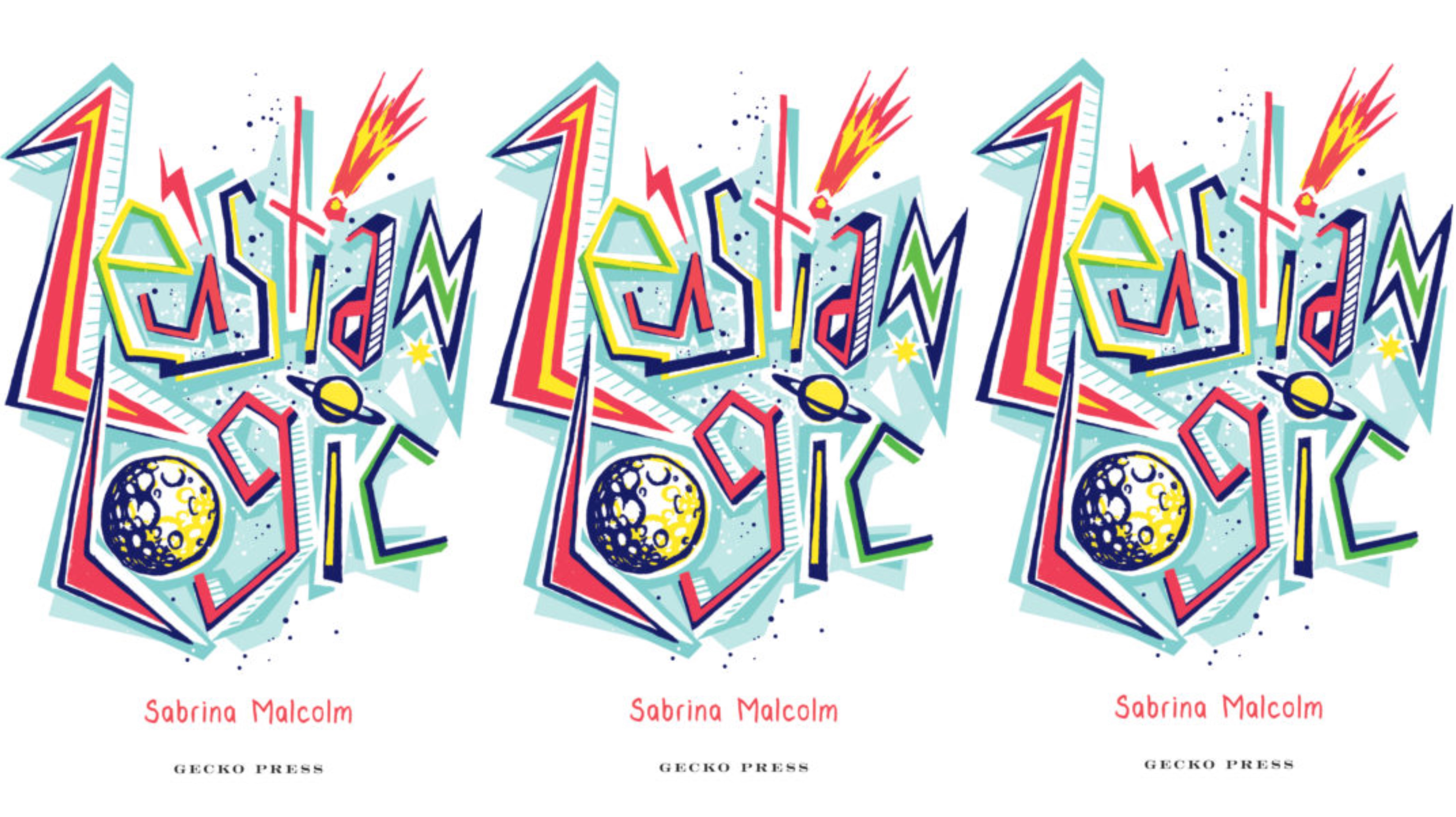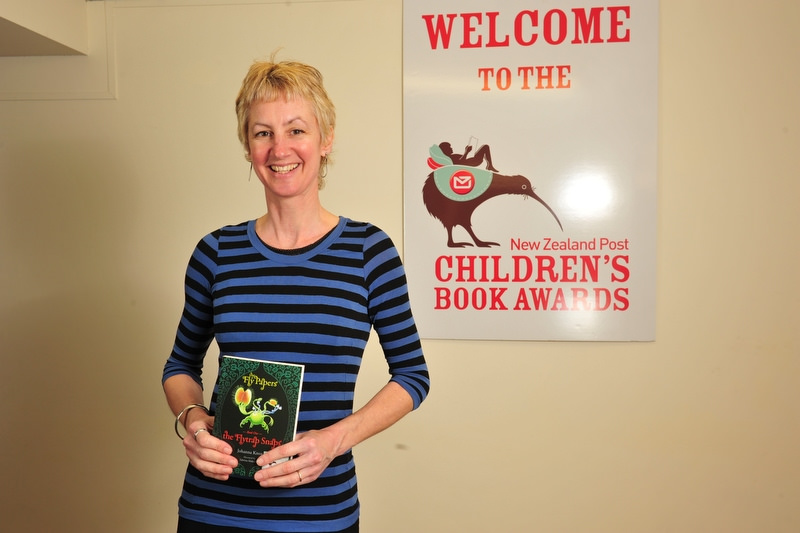Zeustian Logic is Kiwi illustrator Sabrina Malcolm’s first YA novel. She started it during a YA Writing Workshop in 2013 at Victoria University, run by the late (great) Mal Peet. Her classmate, Craig Gamble, interviews her about the novel, published this month by Gecko Press and featuring a mountain-climbing accident, a petrolhead neighbour, a troubled little brother—what boy wouldn’t prefer the company of the Greek gods, astronomists and his best friend, Attila the Pun?

Craig Gamble: The story that is now called Zeustian Logic has been a long time in the making. I remember reading much earlier versions of it in Mal Peet’s writing course back in 2013. But did it exist in a form before that?
Sabrina Malcolm: Yes, it’s been around for a while—my first notes are from 2009. I’m happy to add that I haven’t been toiling on it non-stop since then.
I think the story began with the main character, Tuttle. I started imagining a kid who was a bit nerdy and a bit wryly funny, and who talked a lot without much self-censoring. Before long he became the narrator and principal character.
At the time I was interested in mountain climbing, particularly in the extreme conditions that exist at high altitude and in the daring of climbers who endure them—but also in the ethical dilemmas that can surface when people are on the edge of survival. So those became aspects of the story. Another thing I foisted onto Tuttle was my own long-term fascination with astronomy; and I gave him an enthusiasm for mythology. In a roundabout way, those interests help him sort out his problems.
Originally I wanted to alternate chapters between Tuttle and his younger brother Fen, who are reacting in different ways to the death of their father. I imagined Fen spending most of his time in fantasy worlds, having adventures prompted by the stories in his books; and I wanted it to be ambiguous whether the adventures were real experiences or dreams. Later I realised that wasn’t working, so I took out the fantasy and made Tuttle the main character.
C: Before you wrote this book, you’d illustrated several others, including your own picture book Blue Moon Bird. When did you decide to switch to the novel form, or have you always written longer stories?
S: I don’t remember a decision to switch to novels. I’m sure I started with shorter stories, but I pretty quickly started trying longer things. These days I seem to always have an assortment of short and longer stories on the go. And I’ve noticed that in general, I’ve written for whatever age our Casey was at the time. A couple of weeks ago Casey turned 21, so I’m not sure where that leaves me!
One stand-out difference between the two projects was the number of words, but that didn’t change the process particularly: plenty of words in the novel got just as much nitpicking, exasperated attention as the ones in the picture book.
It made more of a difference that in a picture book, the illustrations tell a part—often a big part—of the story, whereas novels usually have to rely solely on words for characterisation, subplots, atmosphere, all the things illustrations can show. Also, a lot of the thinking about a picture book has to do with design—colour and shapes and arrangement on the page—which are rarely considerations for a novel until later, when the designers do their magic. Even the words in a picture book are subject to design scrutiny.

C: We’ve talked many times about how generous and inspiring Mal was as a teacher. Can you remember what it was about that course in particular that you found encouraging?
S: At the IIML, when you’re in the writing room on the ground floor you can hear when someone is making his or her way downstairs. On the day of the first workshop, we all listened to Mal’s English voice descending as he chatted with the course administrator. It was unreal seeing him walk through the door.
But talking with Mal was so absorbing that everyone quickly relaxed. He loved getting into the nitty-gritty of writing, and it was great to be able to say utterly nerdy things about words and know that he wouldn’t laugh—instead, he’d go one further. So that was encouraging, and his insights and enthusiasm were extremely motivating. There were also plenty of expert writers among my course-mates, and their thoughts and suggestions were inspiring too. It was particularly encouraging if others liked or identified with characters I was working on. On top of all that, analysing the writing of others has a very useful side-effect of pinpointing ways to improve your own.
C: How different is it receiving feedback in a workshop to going through a professional editing process?
S: In a workshop there’s likely to be a broad range of opinions about writing, so feedback for any piece of text will be varied. Advice from one person often contradicts someone else’s. The first few times it happens it’s unsettling, but it makes you learn the knack of taking the advice that rings most true; if you don’t, you can get into an awful mess trying to apply conflicting suggestions.
Another general rule of workshops, though I’m sure there are exceptions, is that grammar and punctuation slip-ups are often disregarded in favour of the wider picture; professional editors don’t usually have that option.
With a single reader such as an editor, of course the feedback is more consistent. In my limited experience, professional editing is more time-constrained and therefore more intensive, and there’s less scope for airily picking and choosing among the suggestions you’re given! But working one-to-one with an editor is a luxury and a fascinating process, and it’s taught me a lot. I’ve had the good luck—in both settings—to work with skilled, tactful people who have made it easy to receive feedback.
C: In Zeustian Logic, the main character Tuttle is coping with the death of his father. But also with the possibility that his father may not have been what he thought he was. We talked in Mal’s class about the idea of offering hope at the end of a book, particularly one aimed at younger readers; is that important to you in this story?
S: When I started, I wanted it to be beyond doubt that Tuttle’s father was cleared of blame for what happened on the mountain. Over time, and with the advice of others, I realised it would be fine—probably better—to make that part more subtle or even take it out. I didn’t want the story to be unrelentingly sad, though, so I worked on making the ending somewhat hopeful. I remember, around that age, preferring stories with a relatively upbeat ending, and I do think that’s a good idea for younger readers.
C: One of the most appealing parts of the book for me is Tuttle’s voice, its richness and authenticity. It’s very appealing and empathetic, and pulls the reader in from the first pages. I remember that being there from the very first draft I read. How hard did you have to work to get that voice?
S: Thank you, it’s a thrill to hear that. I remember one day working on the story, and getting angrier and angrier that the character’s tone wasn’t right. In the end I went back to the beginning in a temper and started banging words out, and that’s how Tuttle got going. It wasn’t a huge change in tone, but it seemed to add an edge that had been missing.
C: What will your next project be?
S: I’m working on finishing a chapter book that’s been on the back burner for a while; after that I’d like to get onto another story for older readers.

Craig Gamble
Craig Gamble lives in Wellington and works at Te Herenga Waka University Press. He completed an MA at the IIML at Victoria University in 2014. His YA manuscript, The Watch List, won the Adam Prize.



